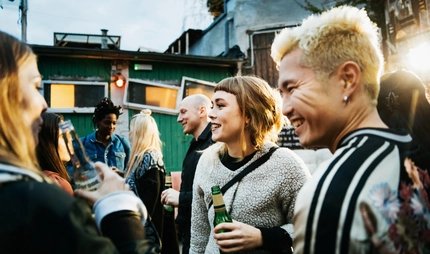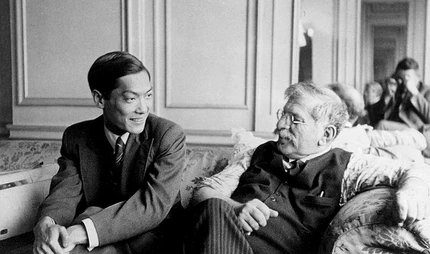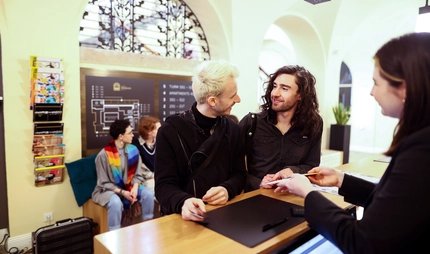
Nollendorfplatz + Winterfeldtplatz
Schöneberg flies the rainbow flag
Where the bohemians of the 1920s once turned night into day, today rainbow flags, trendy bars, culture and a vibrant community characterise everyday life. Like no other neighbourhood in Berlin, Nollendorfplatz in Schöneberg stands for queer life. The diversity that seems natural today is the result of a decades-long struggle for visibility, rights and self-determination. experience one of the most colourful, moving and historic neighbourhoods in the city.
Eldorado, Isherwood & and the Golden 1920s
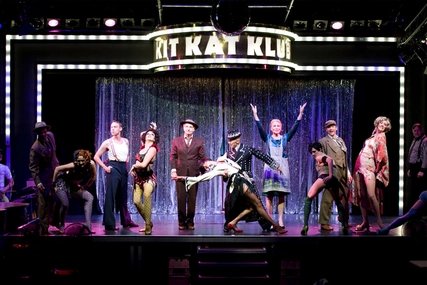
The area around Nollendorfplatz has been a mecca for the queer scene since the 1920s. Marlene Dietrich and Claire Waldoff enjoyed themselves at the Eldorado, then the city's most notorious nightclub. Here, in front of the door at Motzstraße 24, people crowd together, the men in immaculate suits, the women in glittering sequinned dresses. Or are they men in women's dresses? The boundaries become blurred. And what is considered taboo outside is celebrated inside.
Today there is an organic market here, the "Pantry in Eldorado", as the lettering at the entrance proclaims. Just 350 metres away, at Nollendorfstraße 17, a memorial plaque commemorates Christopher Isherwood, who also lived in the neighbourhood. The world-famous film musical Cabaret is based on his Berlin Stories .
Queer scene, culture & living community

Although the lively Golden 1920s are now a thing of the past, there is still plenty to experience here. From Fuggerstrasse and Motzstrasse to Maaßenstrasse and Nollendorfplatz, a wide variety of bars, clubs, restaurants and shops make the Nollendorf neighbourhood a popular nightlife district for the gay and queer scenes.
Whether it's cafés, restaurants, bars, fitness centres, boutiques or bookshops, many of the offers are aimed specifically at the LGBTQI+ audience. And you can see the rainbow flageverywhere in Schöneberg today.
Fittingly, the dome at Nollendorfplatz underground station has been lit up in rainbow colours since 2013, a sign of the neighbourhood's tolerance and diversity. Since the turn of the millennium, a stele by Berlin artist Salomé, a phallic metal pin in rainbow colours with a pink tip, donated by the owners of gay bars, has stood right in front of it. A sign of self-confidence.
On a neighbourhood tour around Nollendorfplatz, a real Berlin drag queen accompanies you through this oldest queer neighbourhood in Europe and gives you insights into its history and current developments.

Memorials & places of remembrance
The Pink Corner, which has been a reminder of the persecution and murder of homosexuals during the Third Reich at the underground station since 1982, is a reminder that colourful coexistence is not a matter of course. Flowers are often placed in front of it.
There are also so-called stumbling blocks. They are placed on the pavements in front of the houses where people who were deported and murdered during the Nazi era lived. Since 2011, they have also been placed in Schöneberg for homosexual men. For example, in Motzstraße no. 9 for Albrecht Krosigk and no. 30 for Otto Hampel.
And since 2019, a large-format house wall at Bülowstr. 94 with a portrait of Walter Degen has commemorated the internment of homosexuals in concentration camps. It is a street art artwork by artist Nils Westergard entitled "The UNforgotten".
A memorialin the Tiergarten also commemorates the homosexuals persecuted by the Nazis. Through a small window, you can see a kiss inside the concrete block, a touching love scene between two same-sex partners, which runs as a film in an endless loop.
CSD, Pride Month & Queer Nightlife
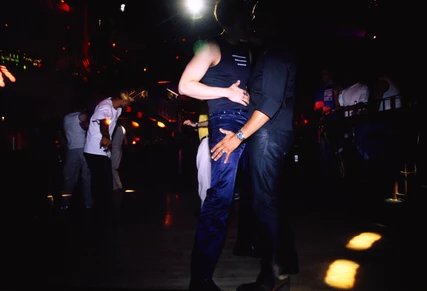
In mid-July, you can experience the Lesbian and Gay Street Festival here in the neighbourhood for a whole weekend. With more than 350,000 visitors, it is one of the largest festivals of its kind in the world and is a fixed part of the Berlin Pride Weeks programme from the beginning to the end of July. More than 200 cultural, political and sporting events take place during Pride Month. In addition to the lesbian and gay street festival in Motzstraße, these include Christopher Street Day, the CSD on the Spree and many other queer party series and formats.
Some pubs and cafés have become true institutions of the scene over the years: Watch the colourful hustle and bustle on Maaßenstraße over coffee and cake. The rustic and cosy Gnadenbrot restaurant or the Elefant restaurant offer more hearty cuisine.
For a relaxed start to the evening, head to the harbour or start the night in the exclusive Heile Welt. The Prinzknecht is known above all for its exuberant theme parties. And of course there are many other clubs where people like to party.
The leather and fetish scene, which is particularly strong in Schöneberg, is drawn to New Action, for example . The lesbian scene meets in the Begine women's pub, which also hosts cultural events and parties.
And in the run-up to Christmas, the queer community invites you to Winterdays and Christmas Avenue under the colourfully illuminated elevated railway at Nollendorfplatz. Here you can get in the festive mood for the holidays between glittering stalls with drag bingo and Aperol o'clock.
What's the best way to get to Nollendorfplatz and Winterfeldtplatz?

The best way to get to the neighbourhood is to get off at Nollendorfplatz. You can get here on the U1, U2, U3 and U4 underground lines. From Nollendorfplatz it is about a 10-minute walk to Winterfeldtplatz. You can also take bus 204 or M19 directly to the Winterfeldtplatz stop. The night bus lines N1 and N2 also run here at night.
FAQ - Frequently asked questions about visiting the Nollendorf neighbourhood
When is the best time to visit the Nollendorfkiez neighbourhood?
The neighbourhood is lively all year round. The summer months are particularly atmospheric, when many events and open-air activities take place. There is a lot going on during Pride Month in July - perfect if you want to experience Berlin's queer life up close.
Which events should I not miss?
Highlights include the Lesbian and Gay Street Festival, Christopher Street Day (CSD), CSD on the Spree and numerous queer parties, cultural and community events. Concerts, readings, parties and exhibitions also take place regularly outside of Pride Weeks.
Is the Nollendorf neighbourhood also worth a visit during the day?
Definitely. Boutiques, bookshops, such as Eisenherz, and other queer shops and cosy cafés characterise the neighbourhood, as do historical sites, memorial plaques and street art. During the day, the neighbourhood shows its relaxed, creative and colourful side.
How safe is the Nollendorf neighbourhood?
The neighbourhood is considered one of the most open and safest places in Berlin for the LGBTQI+ community. Like everywhere in big cities, you should be aware of the usual things at night, but overall the atmosphere is respectful and tolerant.
Is it possible to take a guided tour of the neighbourhood?
Yes, there are special neighbourhood tours that are accompanied by a Berlin drag queen. They offer exciting insights into the queer history and present of the neighbourhood.
Which historical places should I have seen?
The former Eldorado at Motzstraße 24, the memorial plaque for Christopher Isherwoodat Nollendorfstraße 17 and the Magnus pharmacy at Motzstraße 11, which honoursthe founder of the homosexual movement , Magnus Hirschfeld,with its name, are highly recommended. You will also find a number of stumbling blocks here that commemorate the persecution of queer people under National Socialism.
Are there queer programmes specifically for women?
Yes, the Begine is an established meeting place for the lesbian and queer women's scene, with a cultural programme, parties and a café. To get there, walk about eight minutes from Nollendorfplatz down Bülowstraße towards Gleisdreieck and then turn right into Potsdamer Straße.
Is the Nollendorf neighbourhood also suitable for a visit with family or friends who aren't looking for a queer scene?
Absolutely. The neighbourhood is open to everyone and offers a mix of gastronomy, culture, history and relaxed neighbourhood life - a great experience regardless of your identity or community affiliation.



